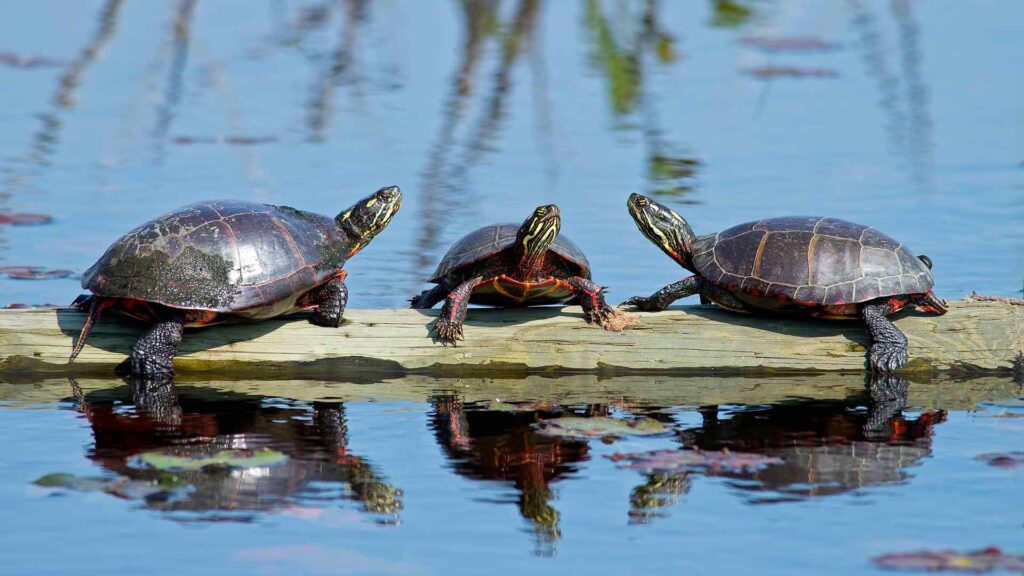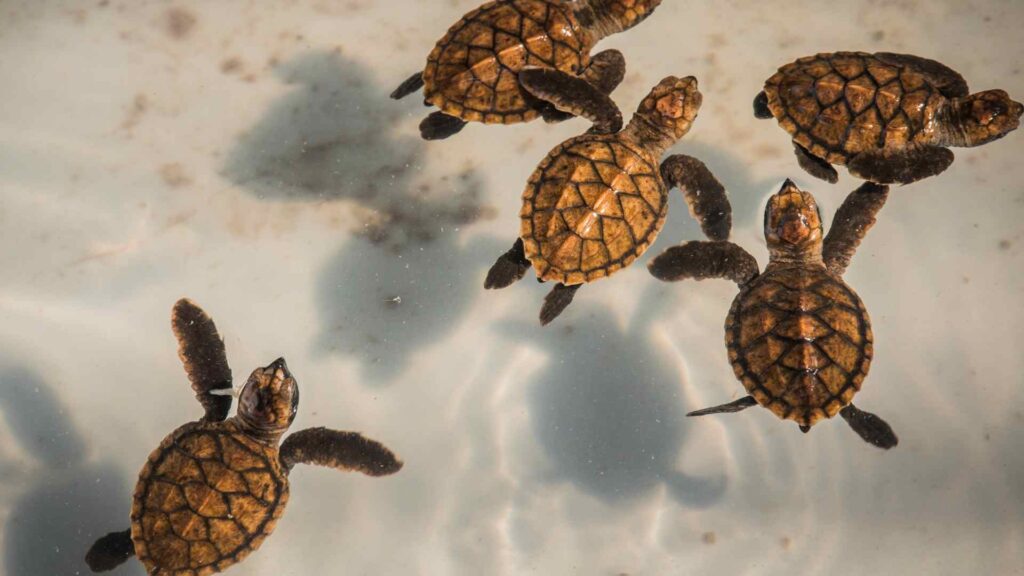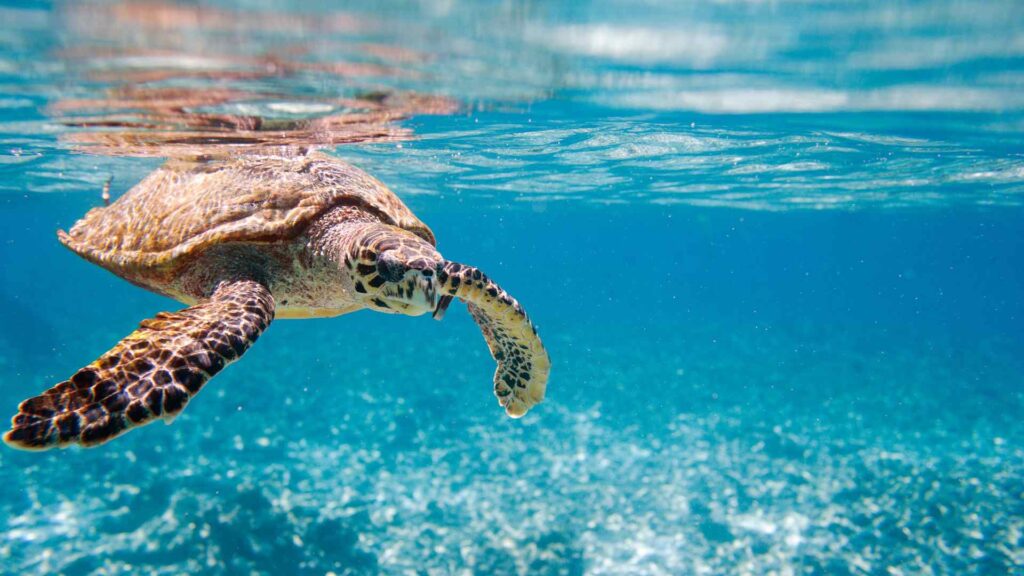Turtles are truly remarkable creatures that have captivated humans for centuries.
With their slow-paced lifestyle and fascinating biology, they hold secrets of evolution, survival, and adaptation.
Let’s explore the world of turtles with 145 fascinating facts categorized into intriguing sections that will leave you amazed by these ancient reptiles.
Turtle Evolution and History
- Turtles have existed for over 200 million years, making them older than dinosaurs.
- The first turtles had teeth and couldn’t retract their heads into their shells.
- Archelon, the largest sea turtle ever, could grow up to 13 feet long.
- Turtles were contemporaries of prehistoric creatures like the T. rex.
- Fossil records suggest that turtles have remained relatively unchanged over millions of years.
- The shell of a turtle evolved as a defense mechanism to protect against predators.
- Some scientists believe turtles are more closely related to birds than lizards.
- Softshell turtles have fossil records dating back to 120 million years.
- Turtles once roamed alongside giant crocodilians in prehistoric swamps.
- Ancient cultures revered turtles as symbols of longevity and wisdom.
- Turtles are mentioned in myths across diverse cultures, including Chinese and Native American lore.
- The phrase “carrying the world on its back” originates from turtle mythology.
- The Galápagos tortoise inspired Charles Darwin’s theory of evolution.
- Turtles were one of the first animals observed in deep-sea habitats.
- Fossilized turtle shells are among the most common prehistoric remains found.

Turtle Anatomy and Physiology
- A turtle’s shell is made up of 50–60 bones fused to its spine and rib cage.
- Turtles can feel through their shells due to nerve endings.
- Their beaks are made of keratin, the same material as human nails.
- Sea turtles can hold their breath for up to 7 hours while resting underwater.
- Turtles don’t have teeth but use their beaks to crush food.
- The color of a turtle’s shell can help indicate its age and health.
- A turtle’s heart can beat for hours after being removed from its body.
- Some turtles can absorb oxygen through their cloaca (a process called cloacal respiration).
- The leatherback sea turtle can dive deeper than any other reptile—up to 4,000 feet!
- Turtle shells come in a variety of patterns, providing camouflage in the wild.
- Female turtles are generally larger than males in most species.
- Box turtles can close their shells completely, forming a tight seal.
- A turtle’s hearing is tuned to low-frequency sounds, ideal for aquatic environments.
- Turtles have excellent eyesight, which helps them spot predators and food.
- Sea turtles have salt glands to excrete excess salt from seawater.
Turtle Behavior and Habits
- Turtles are solitary creatures and prefer living alone.
- They communicate using low-frequency sounds, especially during mating.
- Some species of turtles can migrate thousands of miles across oceans.
- Freshwater turtles are known to bask on logs and rocks for hours.
- Turtles hibernate in cold climates by burrowing into the mud.
- Sea turtles return to the exact beach where they were born to lay eggs.
- Turtles can sense the Earth’s magnetic field and use it for navigation.
- Male turtles often perform intricate mating dances underwater.
- Certain species can climb trees or fences in search of food or safety.
- Turtles can recognize their owners in captivity through sight and smell.
- They are known for their long memory and problem-solving skills.
- Some turtles spend up to 90% of their lives underwater.
- Baby turtles instinctively head toward the brightest light source after hatching.
- Turtles are primarily diurnal but may be active at night in certain conditions.
- They are omnivores and eat a variety of plants, insects, and small animals.

Turtles in Culture and Conservation
- The Teenage Mutant Ninja Turtles were inspired by traditional Japanese ninjas.
- The word “turtle” originates from the French word “tortue.”
- Turtles are often used as symbols of longevity and resilience in art.
- World Turtle Day is celebrated annually on May 23.
- Many ancient civilizations considered turtles sacred animals.
- Turtles appear on the flags and coins of several nations.
- Coastal communities often host turtle-hatching festivals to promote conservation.
- Turtles play an essential role in maintaining marine ecosystems.
- Over 50% of turtle species are threatened with extinction due to human activities.
- Plastic pollution in oceans poses a severe threat to sea turtles.
- Conservationists have established protected nesting beaches for turtles.
- Turtle farming is being explored as a way to reduce poaching.
- Eco-tourism focusing on turtles helps fund conservation programs.
- Leatherback turtles are known as “living fossils” due to their ancient lineage.
- Some religions associate turtles with creation myths, believing the Earth was formed on a turtle’s back.

Bonus Facts About Turtles
- Turtles can live for over 150 years, with some tortoises reaching 200.
- The Galápagos tortoise is one of the longest-living vertebrates on Earth.
- Sea turtles have existed since the time of the dinosaurs.
- The oldest recorded turtle lived to be 188 years old.
- Turtle shells are a mix of bone and keratin.
- A turtle’s shell cannot be removed without killing it.
- Turtles use landmarks to navigate back to their nesting sites.
- Hatchlings use the moonlight to find their way to the sea.
- Turtles help control jellyfish populations in oceans.
- Sea turtles spend most of their lives alone, except during mating season.
- Turtles are ectothermic and rely on the environment to regulate their body temperature.
- Some turtles can survive freezing temperatures by slowing their metabolism.
- Green sea turtles can weigh up to 700 pounds.
- Turtles don’t have vocal cords but can make noises by expelling air.
- Certain turtles are known to “cry” to expel salt from their bodies.
- Loggerhead turtles can weigh over 300 pounds.
- Softshell turtles are among the fastest turtles on land.
- Some turtles can regenerate damaged parts of their shell.
- Turtles were among the first animals in space.
- The shell pattern of every turtle is unique, like a fingerprint.
- Turtles are found on every continent except Antarctica.
- Some turtle species can retract their limbs entirely into their shell for protection.
- Female turtles can lay over 100 eggs in a single clutch.
- The snapping turtle can strike with incredible speed and precision.
- Turtle eggs’ temperature determines the hatchling’s gender.
- Turtles have excellent night vision.
- In some parts of the world, turtles are considered a delicacy.
- Softshell turtles have long necks that they use to catch prey.
- Some turtles dig burrows to escape extreme heat.
- Hawksbill turtles have beautifully patterned shells often sought after in illegal trade.
- The diet of a turtle can influence its shell color.
- Male turtles often have longer claws than females.
- Some turtle species can survive without food for months.
- Turtles play a crucial role in nutrient cycling in aquatic ecosystems.
- Baby turtles are called hatchlings.
- The world’s smallest turtle is the speckled padloper tortoise, found in South Africa.
- Leatherback turtles can swim up to 22 mph.
- Turtles communicate by releasing chemical signals into the water.
- The Aldabra tortoise can weigh over 500 pounds.
- Some turtles hibernate by breathing through their skin.
- Turtle shells are used in traditional medicine in some cultures.
- Female sea turtles can store sperm from multiple males.
- The Mary River turtle can stay submerged for over two days.
- The Kemp’s ridley sea turtle is critically endangered.
- Turtles play a spiritual role in many indigenous cultures.
- Turtles have been depicted in cave paintings dating back 3,000 years.
- A group of turtles is called a “bale.”
- The softshell turtle is known for its pancake-like body shape.
- Turtles help maintain seagrass bed health, vital to ocean ecosystems.
- Many species of turtles are endangered due to habitat loss and climate change.
- Sea turtles have flippers that resemble wings, helping them glide gracefully underwater.
- The green sea turtle gets its name not from its shell, but from the greenish color of its fat.
- Baby turtles have an “egg tooth” to help them break out of their shell.
- A turtle’s digestive system can adapt to eat a wide variety of food, from jellyfish to seaweed.
- The shell of the hawksbill turtle is known as “tortoiseshell” and was historically used in jewelry.
- Turtles are known to clean algae off rocks, improving aquatic habitats.
- Some species can flip themselves back over if they are turned upside down.
- In ancient China, turtles were used in divination practices.
- The olive ridley turtle is known for its synchronized mass nesting events called “arribadas.”
- Turtles use their sharp claws to dig burrows or nests.
- The average lifespan of a pet turtle can range from 20 to 50 years, depending on the species.
- Turtles’ diets often help disperse seeds, aiding in plant growth.
- Certain species, like the bog turtle, are highly elusive and rarely seen in the wild.
- Turtles can be found in freshwater, saltwater, and brackish habitats.
- Their shells are not only protective but also help with buoyancy in water.
- The pancake tortoise has a flat shell to squeeze into rock crevices.
- The Yangtze giant softshell turtle is one of the most critically endangered turtles in the world.
- Turtles are among the few reptiles with a global distribution.
- In some regions, turtles are kept as symbols of good fortune.
- Sea turtles can drink seawater and excrete the salt through their eyes.
- The painted turtle can survive frozen winters by slowing its heartbeat and using stored energy.
- Loggerhead sea turtles can travel thousands of miles across the ocean in their lifetime.
- The Indian star tortoise has a uniquely patterned shell resembling a starry sky.
- Some turtles are capable of “crying” to remove sand from their eyes.
- The pig-nosed turtle is the only freshwater turtle with flippers like a sea turtle.
- Turtles are known to play a role in traditional ceremonies in some Pacific Islander cultures.
- Baby turtles face numerous predators, with only 1 in 1,000 making it to adulthood.
- Turtles use the angle of the sun to navigate during migrations.
- The Matamata turtle is known for its leaf-like appearance, providing excellent camouflage.
- A turtle’s shell can heal itself if cracked, provided the injury isn’t severe.
- Turtles were aboard the Apollo 13 spacecraft as part of scientific experiments.
- Marine turtles often have barnacles growing on their shells.
- The spiny turtle is named for the sharp ridges on its shell.
- Turtles are often seen as symbols of patience and determination.
- Female turtles often outlive their male counterparts.
- Turtles can lose limbs to predators and still survive.
- Hatchling turtles use the vibrations of the group to know when it’s time to emerge from their nests.
- Some turtles dig “false nests” to confuse predators.
- Turtles use their keen sense of smell to locate food underwater.
- The African helmeted turtle is known for its unusual ability to hunt in packs.
- Turtles are cold-blooded, relying on the environment to regulate their body temperature.
- Turtles have a third eyelid, called a nictitating membrane, to protect their eyes underwater.
- Some turtles eat venomous jellyfish without being harmed.
- Female sea turtles sometimes travel thousands of miles to lay eggs.
- Turtles can survive on minimal food and water for long periods.
- The leatherback sea turtle’s body temperature is higher than the surrounding water.
- Turtles are excellent swimmers, with some species reaching speeds of 20 mph.
- In Japan, turtles are considered sacred and a symbol of happiness and prosperity.
- The snapping turtle can extend its neck quickly to catch prey.
- Scientists believe turtles’ slow metabolism contributes to their incredible longevity.
Conclusion
Turtles are ancient wonders of the animal kingdom, blending resilience with a unique charm.
These 145 fun facts highlight their incredible biology, behaviors, and cultural significance. Let’s protect these marvelous creatures for generations to come!
